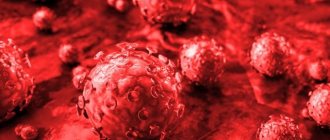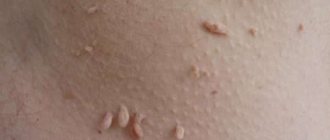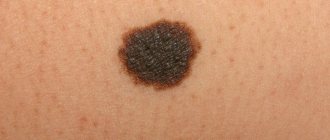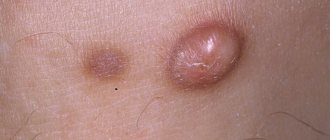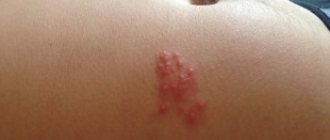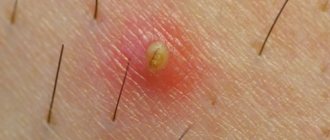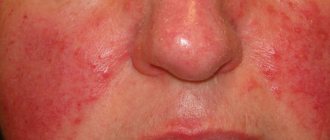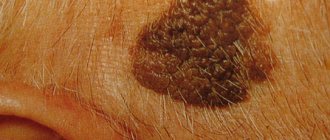A wart is a benign formation on the skin in the form of a nodule or tubercle.
The following types of warts may appear on the neck:
- hanging (thread-like)
- flat
- senile
These types of warts differ significantly from each other, so you can easily distinguish them.
| Characteristic | Hanging | Flat | Senile |
| Appearance | They appear in the form of yellowish bumps, after a while they stretch out and turn into oblong formations on a stalk | A smooth tubercle with a flat top, slightly raised above the skin level (1-2 mm) | A formation with a rough surface covered with horny crusts, rises above the skin more significantly than flat warts |
| Size | 6 - 10 mm | 2-5 mm | 10 – 60 mm |
| Form | Oblong | Usually round or oval, less often polygonal | Spot with jagged edges |
| Color | Flesh, yellowish, shades of brown | Most often - flesh-colored, less often - pale pink, yellowish or brownish | At first - flesh-colored, over time - brown or black |
| At what age can they appear? | Any age | Any age | After 40 years |
| Reasons for appearance | Human papillomavirus | Human papillomavirus | Metabolic changes with age |
| Complaints | No pain, no itching | They don't hurt, they may itch | They don't hurt, they may itch |
If you have small warts on your neck, then most likely they are hanging (most likely) or flat warts.
Warts on the neck
Let's look at what causes nodules of overgrown tissue to appear on delicate areas of the skin. The development of painful skin tumors is caused by the human papillomavirus, a member of the papovavirus family that spreads only among humans. Often the virus “dormants” inside until an external impetus for the development of the disease appears, and then the growth pattern of epithelial tissue changes.
In medicine, the following possible reasons for the penetration into the human body and activation of the papillomavirus are considered:
- Caused by parasite toxins.
- From infected people - carriers of infection.
- Through blood-sucking insects.
- Through water, food, soil.
- Through household items and common areas.
- Due to suppressed immunity (increased background radiation, disturbed ecological living environment, polluted air, prolonged ultraviolet radiation, stress, chronic smoking and other factors).
- After long-term use of antibiotics, which causes disruption of the internal intestinal flora.
- During sexual intercourse.
- During childbirth, it is possible for the child to become infected from the mother.
- Violation of basic principles of hygiene and skin care.
It is the viral nature of the formation of growths that explains why there are more and more of them on the body if no measures are taken and no treatment is taken. With a viral infection, accompanying external symptoms may occur, such as:
- frequent colds, sore throats, nasal congestion;
- allergies of unknown etiology with various forms of rashes, watery eyes and runny nose;
- feeling of constant chronic fatigue;
- frequent causeless headaches;
- disorders of the digestive system (constipation or, on the contrary, diarrhea);
- painful sensations in joints and muscles;
- constant nervousness, causing sleep disturbances and problems with appetite;
- the appearance of dark circles and bags under the eyes.
If there are at least a couple of symptoms from this list, it is necessary to urgently do an antiparasitic cleanse, drink antiviral drugs, and at the same time be sure to take a complex of vitamins.
Types of warts
Ordinary
Most often found in school-age children - 60% of cases and 40% in adults. The causative agent is the human papillomavirus, penetrating through microtraumas.
These are round papules with an uneven, rough surface of a light or grayish color. The size can reach from 0.5 to one and a half centimeters. They are located on the hands, less often on the lips, face, and oral mucosa.
Treatment of the tumor consists of removal using cryodestruction, electrocoagulation or laser. For larger lesions, the surgical method is used. Removal is often done in combination with antiviral treatment.
Flat or youthful
Teenagers under 15 years of age are most often affected. These are flat plaques, usually no more than 5 millimeters, almost not rising above the skin, with clear boundaries, a smooth, non-keratinized surface, light in color, merging with uninfected skin.
They form in groups on the face, arms and legs. This type is not associated with painful sensations, being an aesthetic drawback.
They are diagnosed relatively rarely, leaving 4% of all cases of incidence. They are viral in nature, entering the body through damage to the skin and mucous membranes.
The manifestation in adolescence is due to hormonal changes in the body and reduced immunity. During adolescence, the skin produces excess sebum and sweating increases – favorable conditions for the formation of the virus. Additionally, risk factors include razor burn and poor hygiene.
It is detected by visual examination and dermatoscopy. They are removed using methods that do not leave scars, which is important when localized on the face. This is a laser and radio wave technique.
Plantar

They are a type of flat and make up 34%. Located on the soles of the feet, balls of the feet and between the toes.
The virus that causes the tumor multiplies in a humid environment, so infection is possible in saunas, swimming pools, gyms, with hyperhidrosis and wearing uncomfortable shoes.
This is a neoplasm of a dense structure, consisting of many fused papillae, in the center of which there is a dark dot - a clogged capillary. It has a round shape, yellowish or gray color. Usually appear singly.
Removed due to painful sensations that intensify when walking. In addition, this species can grow and grow together, becoming inflamed.
To distinguish between plantar warts and calluses, dermatoscopy and ultrasound are used. To remove plantar warts, electrocoagulation is least often prescribed, which is due to the depth of penetration. The most optimal way to remove warts on the foot is laser
Genital warts (anogenital)
They are located in the intimate areas, also on the cervix, inside the urethra or in the mouth. In the initial stage - small bumps with redness, accompanied by itching. In the future, the growths can reach one and a half centimeters, and the itching in the area of occurrence intensifies.
The disease is transmitted sexually, less often by contact: toilet rim, bathtub, hygiene items. It may appear after several weeks or years due to decreased immunity.
It is important to note that a condom does not guarantee 100% protection, since formations can be located on unprotected skin and can be transmitted through contact.
Diagnosed by a specialist during examination, all methods are used for treatment, supplemented by immunomodulatory therapy.
Senile warts or keratomas

The only variety of non-viral nature. The exact causes of its occurrence are unknown, but it has been proven that a number of factors can significantly increase the likelihood of occurrence.
At risk are people suffering from oily seborrhea, often exposed to the sun, and receiving insufficient amounts of vitamins and minerals. Poor nutrition, in particular, excess animal fats and deficiency of vegetable oils, also has a negative effect.
The initial stage of seborrheic keratosis is a yellow or brown spot. Then small papules appear, degenerating into a keratoma - a dark-colored, oval-shaped formation that rises above the skin. At the fourth stage it becomes horny.
Keratomas are dangerous due to the possibility of degeneration, therefore they must be monitored in a medical facility.
Diagnostic methods: dermatoscopy, ultrasound, siascanning. They are treated with conservative therapy, laser, cryodestruction, radio wave method. If cancer is suspected, surgical excision is practiced.
Filiform warts or papillomas
They appear under the influence of HPV on the face, eyelids, around the eyes, on the neck, in the folds of the groin, under the breasts, in the armpits. Externally, the papules are flesh-colored, soft, often with a stalk. The length ranges from 1 millimeter to three centimeters.
Older people over 35 years of age are susceptible. Often the appearance is due to hormonal changes: pregnancy, obesity, menopause, diabetes.
Experts recommend removing papillomas if they are located in places prone to injury, for example, on the neck and under the chest.
For diagnosis, visual examination or dermatoscopy is used. Surgical excision is the least commonly used treatment; cryodestruction, electrocoagulation, radio waves and laser are effective.
be careful
The presence of papillomas, warts, condylomas, moles and spines on the body is the first sign of malignant melanoma!
We hasten to warn you that most medications “treat” warts, papillomas, moles, etc. - this is a complete deception of marketers who make hundreds of percentage points on drugs whose effectiveness is zero. They do not cure the disease, but only mask the symptoms.
The pharmacy mafia makes huge money by deceiving sick people.
But what to do? How to treat if there is deception everywhere? Doctor of Medical Sciences Anatoly Makhson conducted his own investigation and found a way out of this situation. In this article, the Doctor also told how to 100% protect yourself from melanoma, for only 149 rubles! Read the article in the official source via the link.
What are warts and should you be afraid of them?
This is the name for epithelial viral tumors that are a consequence of damage to the body by the papillomatous type of virus, papillomavirus. The word “tumor” should not be scary: these neoplasms are predominantly benign.
According to the International Classification of Diseases, 10th revision (ICD-10), the nosology “viral warts” is assigned code B07. In this case, papillomas are excluded:
- larynx;
- cervix;
- Bladder;
- venereal warts.
Papillomatosis is the cause of tumors in the neck, vocal cords, bladder, nasal and oral mucosa.
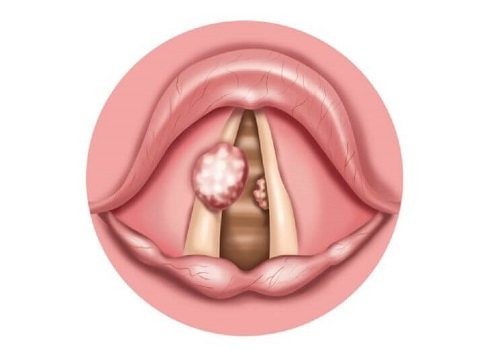
Papillomas may appear on the vocal cords
Some types of HPV are oncogenic: it is highly advisable to carry out preventive examinations 1-2 times a year. Various types of HPV are found in individuals with gynecological pathologies. Papillomatosis occurs equally often in men and women, in children and pregnant women.
Small warts on the neck
Most often, hanging small skin growths are localized in one place. They may additionally appear due to mechanical effects on the skin in the collar area (rubbing with clothing, shaving, scratching the painful area). Small formations, usually multiple, have a smooth surface covered with scales. Their color is slightly yellowish or matches the color of their skin.
A woman’s neck disfigured by tubercles does not look very aesthetically pleasing. It is necessary to take action immediately from the moment the first, even small, uncomfortable growth appears on the neck.
Folk remedies
Treatment with folk remedies is not effective enough and is only permitted after consultation with the attending physician. Traditional recipes can be used in combination with other methods of therapy.
Traditional healers recommend removing a wart on the neck using celandine juice. Juice is applied directly from the plant stem to the growth.
They resort to this procedure for 2-3 weeks. You should be careful with this method, since celandine is a poisonous plant and can burn healthy areas of the skin.
In addition, onions and garlic are also used. A paste is made from vegetables, which is applied to the wart on the neck and secured with a bandage or adhesive plaster.
Mostly leave the compress overnight and wash it off in the morning with warm water. The manipulations are carried out for 2 weeks.
Acetic acid is also used, which is important to carefully apply to the wart on the neck. Since it has a cauterizing property, scars may remain.
Doctors' opinions on the most effective methods of treating warts and papillomas
The chief physician of Moscow City Hospital No. 62 describes his vision on this matter. Anatoly Nakhimovich Makhson Medical practice: more than 40 years.
“I have been treating people’s papillomas and warts for many years. I’m telling you as a doctor, papillomas along with HPV and warts can really lead to serious consequences if they are not dealt with.
The human papillomavirus is present in everyone on whose body there are papillomas, moles, warts and other pigmented formations. According to rough estimates, 80-85% of the planet's population has it. By themselves they are not dangerous. The problem is that an ordinary papilloma can become melanoma at any time.
These are incurable malignant tumors that kill a person in just a few months and from which there is no salvation.
Unfortunately, in Russia and the CIS countries, pharmaceutical corporations sell expensive medications that only relieve symptoms, thereby hooking people on one drug or another. That is why in these countries there is such a high percentage of cancer diseases and so many people suffer from “non-working” drugs.
The only drug that I want to recommend, and it is also officially recommended by WHO for the treatment of papillomas and warts, is Papinol. This drug is the only remedy that has an effect not only on external factors (that is, it removes papillomas), but also acts on the virus itself. At the moment, the manufacturer has managed not only to create a highly effective product, but also to make it accessible to everyone. In addition, within the framework of the federal program, every resident of the Russian Federation and the CIS can receive it for 149 rubles.”
To find out more, read this article.
Warts: what are they, why are they dangerous and how to treat them
Recent studies have proven that the cause of warts is the human papillomavirus or HPV.
This is the most common virus, which, according to some estimates, affects up to 80% of the population. For some, the virus is active, for others it does not manifest itself for many years and even throughout life. However, everyone has the risk of receiving such a dubious “decoration”.
What causes the manifestation of the disease, what does it threaten, can it be cured, what methods of removing warts are accepted and how to avoid them?
Warts on the neck - treatment
In order to quickly and permanently get rid of negative skin benign tumors on the neck, you should strictly use special potent pharmaceutical drugs according to the instructions.
Many patients infected with the virus do not know how to remove tumors from the delicate skin on the neck without leaving a clear trace of the impact. In this case, you just need to strictly follow the recipe and use the medications very carefully so as not to get severe irritation and burns to healthy areas of the skin.
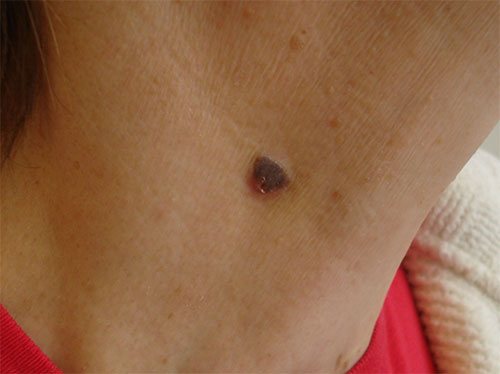
Detailed information on the use of drugs freely sold in pharmacies, the action of which is aimed primarily at removing excess epithelium, is presented below in the lines of the following table.
| Name of the drug | Compound | Action |
| Feresol | Phenol (carbolic acid) and tricresol. | They are a very strong poison. They literally burn and mummify warts and kill fungi. |
| Verrucacid | Phenol (carbolic acid) and metacresol. | |
| Collomak | Salicylic and lactic acid. | Destroy warts and attack fungi. |
| Iodine solution | Iodine. | |
| Panavir | The active substance from potato extract is solanine. | Cauterizes the surface of formations. Solanine, cut from the green part of raw potatoes, has the same healing effect. |
| Cryopharma | Cryopreparation. | Warts are quickly removed using local low freezing (cryotherapy) on a small area affected by a wart, without leaving any marks on the skin after treatment. |
| Wartner cryo | Cryopreparation. | |
| Antitoxin NANO | Ingredients: thistle, rosemary extract, bearberry (bear ears), echinacea extract. | It fights not only warts, but also eradicates their very cause - the virus. |
| Super clean | Contains strong alkalis - oxides of potassium hydroxide and sodium hydroxide. | To remove growths on the feet and heels, as after their use lifelong stains remain. Do not use on delicate neck skin. |
Important! In any case, before using a medicinal product, you must carefully read the instructions for use of the drug so as not to harm your tissues.
The occurrence of any side effects and allergic reactions from the effects of the drugs indicated in the table depends on many factors, including: individual tolerance of the body, gender, age and immunity. Therefore, before you begin to eliminate the painful growths that have appeared on your neck, you must consult a dermatologist.
A specialist will not only determine the type of tumor based on its appearance, but will also perform a dermatoscopy using a modern digital dermatoscope and a scraping from the affected surface, which will be sent for laboratory analysis (histology) to clarify the diagnosis. Having received the results, the doctor will select a well-tolerated, adequate individual treatment for the patient.
Removal methods
There are several methods. The essence comes down to the destruction of tissue by mechanical action or drugs. To localize the source of the disease, antiviral ointments are prescribed.
Statistics say that the effectiveness is about 90%, and relapses occur in a quarter of those who apply. The main factor on the path to successful treatment is contacting a specialist at an early stage.
Prices for wart removal start from 150 rubles.
Electrocoagulation
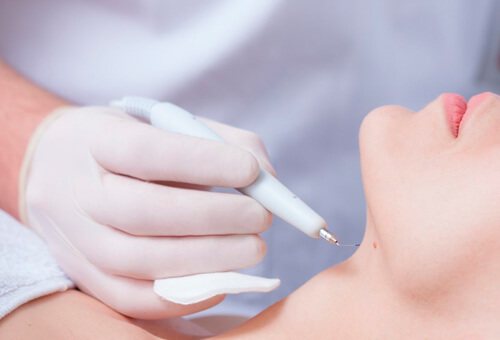
A proven and reliable method for removing warts. Particularly recommended for pedunculated formations.
Electrocoagulation of warts occurs using alternating current, while tissue is simultaneously removed and blood vessels are cauterized, making the recovery process faster and a scar not formed.
Anesthesia with local anesthesia takes 10-20 minutes.
The cost is affordable, affordable and depends on location and size. Prices start from 300 rubles.
Laser removal of warts
A relatively new technique. The laser beam evaporates the affected cells, leaving a slight depression that heals after 10-20 days without a trace.
Laser wart removal is painless, uses local anesthesia and takes five minutes.
It can be performed on any part of the body; there are limitations in the use of the technique in young children and large lesions.
The price of the laser wart removal procedure is from 200 rubles per unit.
Cryodestruction

Removing warts with liquid nitrogen is no less common. The affected tissues are frozen, the cells die and die.
Nitrogen is applied to the desired area using an applicator, applying for a couple of seconds. After this, the tissue turns white, thickens, then a bubble appears, which subsequently dries out and the crust completely disappears after 1-2 weeks. The method of removing warts with nitrogen does not leave scars or scars.
The method is painless and recommended for children.
The cost is very affordable and starts from 150 rubles per unit. The cost decreases when liquidating a large number of units at one time.
Radio wave method
This is removal using a radio knife; under the influence of high-frequency radio waves, the liquid in the cell evaporates, which leads to its disappearance. The advantages of removing warts using the radio wave method are the procedure without blood, burns, pain, or scars.
The resulting crust disappears after a week. After the procedure for removing warts using radio waves, swelling and inflammation do not appear.
The cost of the procedure starts from 300-500 rubles and depends on the area of the surface being treated, as well as the location.
Surgical excision
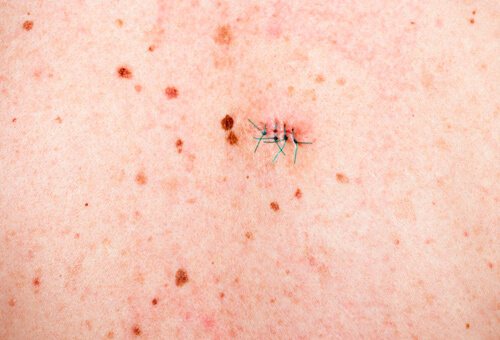
Prescribed for large affected areas. In this case, the tissue is excised with a scalpel and the incision is sutured. After surgical removal of a wart, a scar remains.
The cost of one unit is from 350 rubles.
Chemicals
Can be prescribed by a doctor if necessary. Treatment and removal of warts with chemical agents should be carried out strictly under the supervision of a specialist.
Removal at home
Strictly prohibited. Folk remedies, improvised methods and chemicals used without a doctor’s prescription and supervision will be ineffective or dangerous to health. Removing warts using traditional methods can provoke further spread and degeneration into malignant forms.
To avoid a relapse, medical professionals advise eating right, getting rid of bad habits, taking vitamin and mineral complexes, leading an active lifestyle, washing your hands thoroughly, and not using other people’s things.
Wart removal
To date, there is no method that would give a 100% result in getting rid of unpleasant growths. Indications for removing a wart on the neck are:
- large size of education;
- discomfort from constant rubbing;
- the growth is located in an area of increased trauma;
- aesthetic reasons - the growth disfigures its owner.
Only a specialist will be able to diagnose the benign nature of the formation; without such a diagnosis, any manipulation of the wart is strictly prohibited. If there is no discomfort from the formation, the specialist may refuse to prescribe treatment, since the best thing in this case is not to cause more harm than there is (in the form of a wart).
If the tumor itches, turns red, or changes color, these are additional reasons to seek advice from a specialist. Self-medication in this case can lead to disastrous results.
This is reported by official medical sources and traditional medicine. Treatment of formations on the neck often involves their removal. However, the skin of the neck is sensitive, thin, and requires a more delicate approach, so before removal it is worth turning to other methods of influencing them:
- regular hygiene and sweat control;
- increasing general and local immunity;
- wearing comfortable clothes that do not restrict the neck area;
- reducing the incidence of colds and viral diseases;
- formation of a positive outlook on the world, solving psychological problems.
If, after following the above rules, the warts do not disappear, drastic measures are taken. There are several ways to remove warts in a specialist’s office:
- Laser removal, which allows you to remove the growth layer by layer, right down to the root.
- Electrocoagulation using devices that capture and remove growth using current.
- Cryodestruction, i.e. freezing with liquid nitrogen. For cervical warts, the method is not used so often because it is quite painful for this area of the body.
You can also get rid of the growth yourself by using medications with similar effects - Cryopharma, Superchistotel, Solkoderm, Ferezol, Viferon, etc.
These drugs have different aggressiveness towards the growth and the method of action, so they are used extremely carefully for the cervical area.
Types of warts
There are 40 types of HPV that are common and cause tumors. For example, common warts on the fingers are caused by type 7 virus. Common warts occur when infected with type 2. In people with weakened immune systems, the appearance of warts is associated with infection with HPV types 26 and 27.
Simple, thread-like and pointed neoplasms can be found on the neck. They all look different, but they are warts.
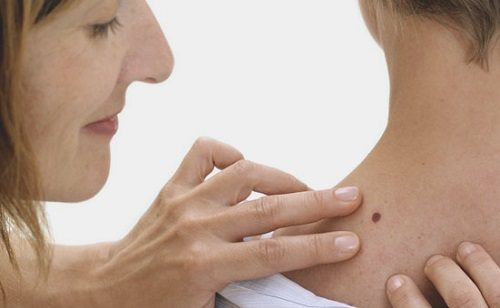
3 types of warts are diagnosed on the neck
Simple:
- Common in children and schoolchildren.
- In addition to the neck, they appear on the arms - hands, palms. Sometimes on the face and mucous membranes.
- They have a round shape, are dense, rough and uneven to the touch. Colored in skin color, sometimes pinker, yellower or darker, browner. Can be well pigmented.
- In some cases, many fused growths are found.
- If there are several formations, one large one can be identified. After removing the large one, the small ones that were nearby spontaneously disappear.
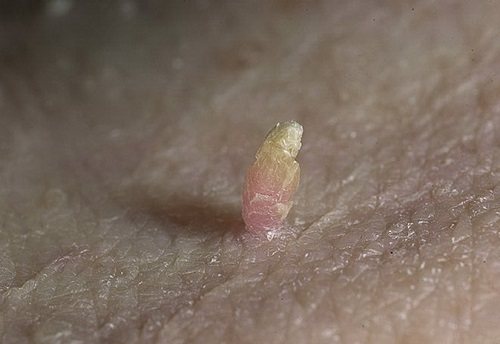
Thread-like warts are soft to the touch
Filiform:
- This type is more common on the neck. Also in the groin area, armpits, eyelids, mammary glands.
- They are susceptible to injury due to the fact that they rise on a leg. Soft to the touch, not rough.
- The color is flesh or darker.
Genital (or condylomas):
- Visually, the formations are rough and lobed.
- Upon examination, a leg is noticeable.

Condylomas are colored pinkish - They do not differ from the skin color or are pinkish.
- When injured, they quickly turn red, may bleed, hurt, itch, and turn black.
Genital warts tend to form extensive conglomerates.
